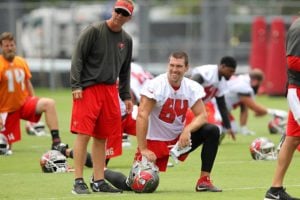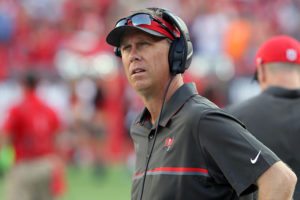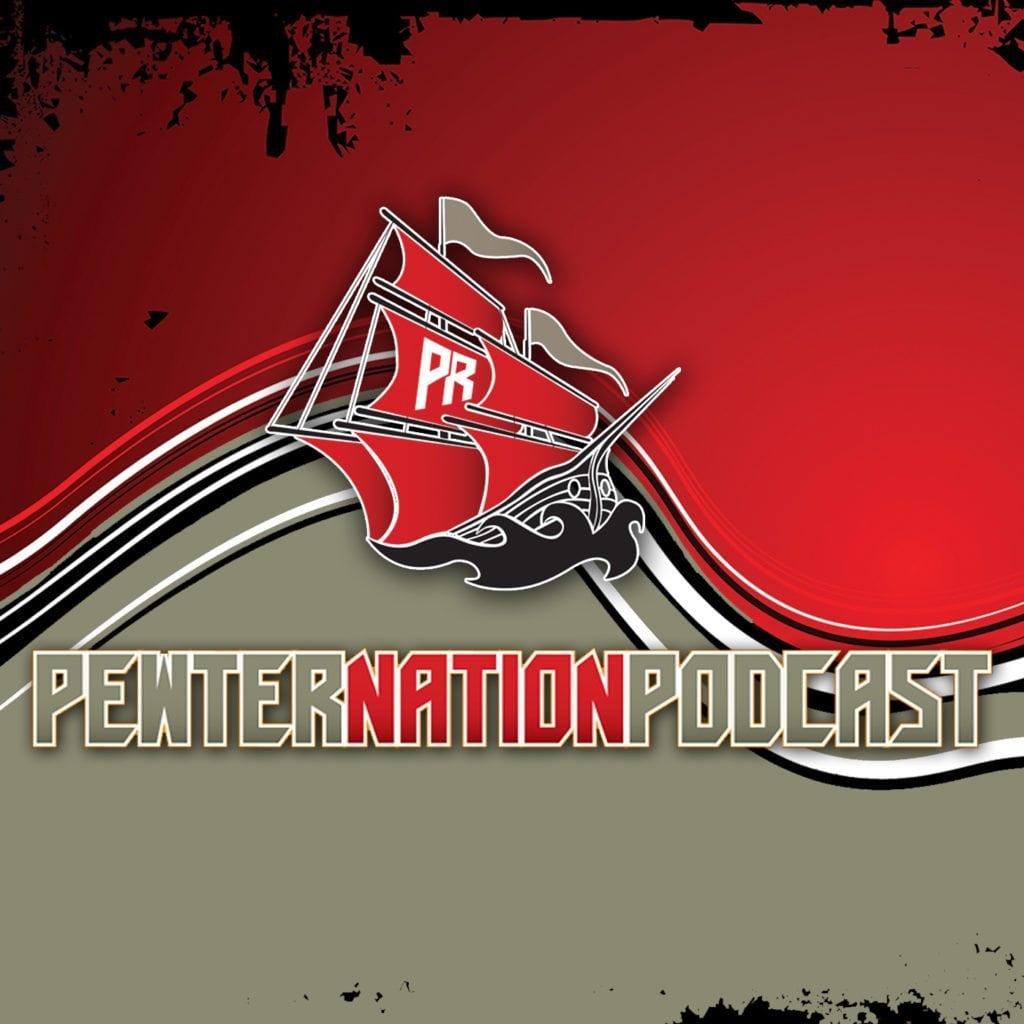FAB 2. Monken’s Mission Is Fixing Bucs’ Red Zone Offense
The Buccaneers won’t play a regular season game for eight more months, but they have already notched a win.
That came when head coach Dirk Koetter wisely named Todd Monken the team’s full-time offensive coordinator and promoted Skyler Fulton to the role of wide receivers coach. Monken, who is a hell of a coach, had been doing double duty in those two areas for each of the past two seasons.
Now it’s up to Monken to help the Bucs win a lot more than five games in 2018 after going 5-11 last year. Where he figures to help the most is fixing Tampa Bay’s red zone woes.

Bucs OC Todd Monken and TE Cam Brate – Photo by: Cliff Welch/PR
Monken has overseen the continued development of Tampa Bay’s top red zone target, Mike Evans, over the past two 1,000-yard seasons, including the 2016 campaign, which was Evans’ first Pro Bowl year. Monken also helped develop rookie Chris Godwin, who will vie for more playing time after he caught 34 passes for 525 yards and a 15.4-yard average, which was highest among Tampa Bay’s receivers. Godwin also caught the game-winning, 39-yard touchdown with seconds left in the 2017 season finale against New Orleans.
Now Monken will his spend his whole time overseeing the entire Bucs offense. Instead of being confined to working with the receivers during practice, Monken will be a walk-around coordinator, inspecting every unit on the field and lending his assistance in all areas of the offense in an effort to increase point production.
While Koetter will still call plays on game days, it is believed that Monken will have more influence and a greater ability to help with the game plan during the week in the film room and in suggesting calls to Koetter, who has a lot on his plate on the sidelines when it comes to clock management and managing personnel due to injuries in the heat of battle.
Monken has typically been on the sidelines coaching the receivers on game day, but may move up to the coaching box for a better view. Such a move to sit alongside defensive coordinator Mike Smith and work upstairs with tight ends coach Ben Steele and other Bucs assistants could prove to be advantageous and lead to better play calls, which could ultimately lead to more points scored.
Over the next two months before the players return to One Buccaneer Place for on-field work in April with the return of OTAs (organized team actitivies), Monken’s number one focus will be to examine what went wrong in the red zone last year and help fix it. By keeping Koetter and his staff intact for the 2018 season on the heels of a very disappointing 2017 campaign, the Glazers have put the coaches on notice that they have one year to right the ship and sail back towards the playoffs.
Regardless of how much the defense improves this offseason with added talent, if the Bucs don’t score more than the 20.9 points per game that they averaged last year there will be regime change in 2019. And with the likes of quarterback Jameis Winston, running back Peyton Barber, wide receivers Mike Evans, DeSean Jackson, Adam Humphries and Godwin, and tight ends Cam Brate and O.J. Howard, there’s no reason why Tampa Bay shouldn’t be scoring in excess of 25 points per game.
The Bucs were 4-2 in games in which they scored 25 points or more last year. Had Tampa Bay scored 25 points in losses to Carolina (twice), an early-season loss against New England, and in December home losses to Detroit and Atlanta, the Bucs would have been 10-6 last year and likely snapping a nine-year playoff drought.
Tampa Bay’s red zone woes first appeared in the preseason, where points were at a premium.

Bucs OC Todd Monken – Photo by: Cliff Welch/PR
“It’s there. We know it. We understand it,” Monken said back in September. “It was something that we tried to focus on in the offseason. What do we have to do? We’ve got to coach it better [and] we’ve got to rep it better during the week, so we execute better come Sunday. I don’t think it was a lot of things schematically, although we have to look at that. We obviously have to coach it better. We have to do a better job of being able to run the ball in when we get those opportunities because the teams that are best in the red zone can run it in. That’s what they’re able to do, so we have to do a better job there and we have to do a better job when we get opportunities on the perimeter of making the plays that are afforded to us. That’s really it. But, it is a priority to us. Obviously, we need to continue to improve in there and obviously in the preseason we didn’t get it done like we need to get it done come Sunday.”
The Bucs didn’t run the ball better in the red zone or anywhere on the field last year as the team’s ground game ranked 27th in the league, averaging a paltry 90.6 yards per game on the ground. Overhauling the Bucs’ backfield by signing a couple of running backs in free agency and adding one in the draft should help, in addition to upgrading the talent at guard this offseason.
Koetter’s offense moved the ball at will for the most part in 2017, finishing ninth in the league with a 363.5-yard average per game. Tampa Bay was fourth in the NFL in third down offense last year (43.4 percent, 85-of-196) and was second in the NFL in first downs with 352 – trailing only New England (389). The Bucs had the NFL’s fourth-ranked passing attack, averaging 272.9 points per game.

Bucs OC Todd Monken and head coach Dirk Koetter – Photo by: Cliff Welch/PR
But points win games – not yards – and that’s something that Monken is well aware of. If you don’t think scoring offense matter, look no further than Sunday’s Super Bowl match-up against New England and Philadelphia. Both the Patriots and the Eagles were tied for second in the league in scoring offense, averaging 26.8 points per game.
Monken addressed what was wrong with the red zone this year in his final press conference of the year prior to the Saints game.
“We already talked about being able to score touchdowns in the red zone and not turning the ball over,” Monken said. “It is pretty simple. It is really a simple formula, [but] it is harder to get it done. Otherwise we would have it done.
“It usually comes down to lack of execution. I don’t know what else you say about it. When you don’t score down there, [in] some way, shape or form we got out-played. We got out-coached. There is no other way to put it. … Ultimately, you are going to have a hard time winning, especially where we are at as a team at this point, kicking a bunch of field goals.”
There were a lot of random issues that plagued the Bucs’ red zone offense from missed field goals to bad snaps to fumbles to penalties – each rearing its ugly head at the most inopportune time. Now it’s up to Monken to take the lead in fixing Tampa Bay’s red zone woes by finding the right plays that will produce touchdowns and eliminating the mistakes that costs the team points. Of course having a better running game in 2018 would be a big step in the right direction.
Scott Reynolds is in his 30th year of covering the Tampa Bay Buccaneers as the vice president, publisher and senior Bucs beat writer for PewterReport.com. Author of the popular SR's Fab 5 column on Fridays, Reynolds oversees web development and forges marketing partnerships for PewterReport.com in addition to his editorial duties. A graduate of Kansas State University in 1995, Reynolds spent six years giving back to the community as the defensive coordinator/defensive line coach for his sons' Pop Warner team, the South Pasco Predators. Reynolds can be reached at: [email protected]


